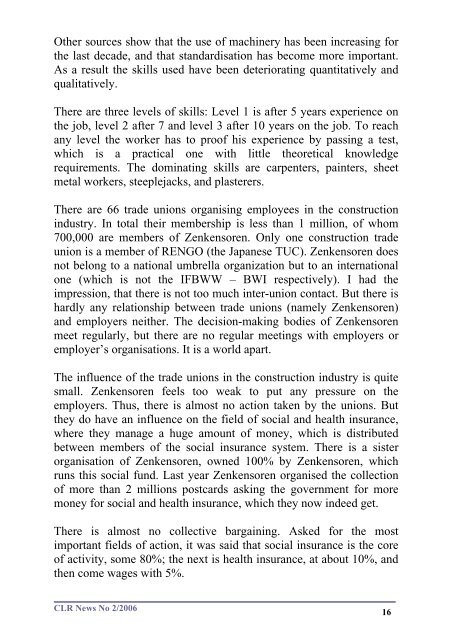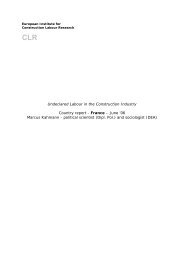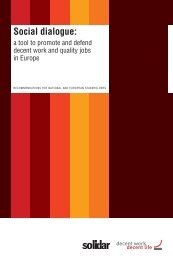Japan – what can we learn? - Construction Labour Research
Japan – what can we learn? - Construction Labour Research
Japan – what can we learn? - Construction Labour Research
You also want an ePaper? Increase the reach of your titles
YUMPU automatically turns print PDFs into web optimized ePapers that Google loves.
Other sources show that the use of machinery has been increasing forthe last decade, and that standardisation has become more important.As a result the skills used have been deteriorating quantitatively andqualitatively.There are three levels of skills: Level 1 is after 5 years experience onthe job, level 2 after 7 and level 3 after 10 years on the job. To reachany level the worker has to proof his experience by passing a test,which is a practical one with little theoretical knowledgerequirements. The dominating skills are carpenters, painters, sheetmetal workers, steeplejacks, and plasterers.There are 66 trade unions organising employees in the constructionindustry. In total their membership is less than 1 million, of whom700,000 are members of Zenkensoren. Only one construction tradeunion is a member of RENGO (the <strong>Japan</strong>ese TUC). Zenkensoren doesnot belong to a national umbrella organization but to an internationalone (which is not the IFBWW <strong>–</strong> BWI respectively). I had theimpression, that there is not too much inter-union contact. But there ishardly any relationship bet<strong>we</strong>en trade unions (namely Zenkensoren)and employers neither. The decision-making bodies of Zenkensorenmeet regularly, but there are no regular meetings with employers oremployer’s organisations. It is a world apart.The influence of the trade unions in the construction industry is quitesmall. Zenkensoren feels too <strong>we</strong>ak to put any pressure on theemployers. Thus, there is almost no action taken by the unions. Butthey do have an influence on the field of social and health insurance,where they manage a huge amount of money, which is distributedbet<strong>we</strong>en members of the social insurance system. There is a sisterorganisation of Zenkensoren, owned 100% by Zenkensoren, whichruns this social fund. Last year Zenkensoren organised the collectionof more than 2 millions postcards asking the government for moremoney for social and health insurance, which they now indeed get.There is almost no collective bargaining. Asked for the mostimportant fields of action, it was said that social insurance is the coreof activity, some 80%; the next is health insurance, at about 10%, andthen come wages with 5%.CLR News No 2/200616









